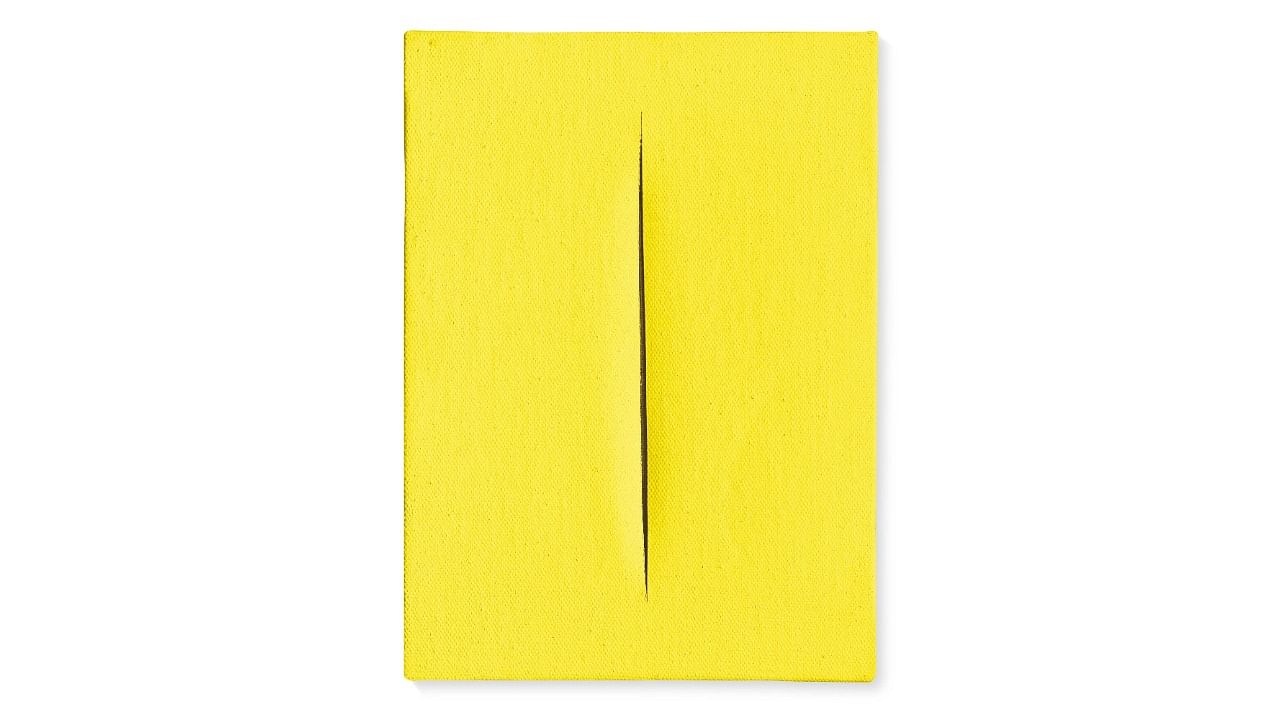
Concetto spaziale, Attesa
ic courtesy: Christie's
A knife, one of the oldest tools invented by humans, is as much a vital implement that no kitchen can function without as it is a feared weapon in the hands of a criminal.
In an ironic twist, it has now appeared as a symbol of human resilience, a courageous rebuttal to attempts at smothering free speech. An empty sheet of paper slashed by a knife is the powerful cover of Salman Rushdie's memoir titled Knife: Meditations After an Attempted Murder. As is well-known by now, it is the author’s account of the knife attack, an attempt to murder that he survived while on stage to deliver a lecture on the importance of keeping writers safe, at the Chautauqua Institution in New York State, on August 12, 2022.
The first look of the cover evoked in my mind the famous slash paintings of the Argentine-Italian artist Lucio Fontana (1899-1968), who gave a new vocabulary to global modern art by puncturing and slashing the canvas; art which now sells for millions of dollars at auctions. Fontana is not much known in India, but his art gained widespread currency with two major retrospectives: In 2014 at the Musée d’Art Moderne de la Ville de Paris, and in 2019, at New York’s Metropolitan Museum of Art, with an exhibition titled ‘Lucio Fontana: On the Threshold’.
However, unlike the Rushdie story, Fontana’s journey to create this language of art had nothing to do with violence. It was rather an exploration of space through holes (buchi) and cuts (tagli) in the canvas or other medium, which came to be known as the Spatialist movement in modern art, or Spazialismo in Italian.
Fontana was born to Italian parents in Argentina and throughout his life, lived intermittently between the two countries. In 1946, he co-founded the experimental Altamira School of Arts in Buenos Aires, and in the same year published Manifesto Blanco (The White Manifesto), which set out goals for the creation of ‘spatialist’ art. He called upon his students to engage with new technology—including the use of light—to relook at the arts. Around the same time, the first images of the Earth from space became widely available, which added to his latent interest in the concept of space and space travel. He began by puncturing holes in his sculptures and canvas, and soon slashes followed. Fontana is known to have said, “It is not true that I made holes in the canvas to destroy it, no, I made holes to discover, to find the cosmos of an unknown dimension.”
Most of these canvases are monochromatic, their surfaces lacerated with holes and cuts, with specialists likening the former to the lunar surface, rugged, serene, and inexplicably enchanting. Gradually, the artist added similar works in wood, metal and other media. Another striking series is his La Fine di Dio, 1963-64, which comprised paintings exhaustively punctured with holes of different sizes. It is widely believed to be inspired by the first human journey into outer space, completed by Yuri Gagarin in April 1961.
Spatialism, as pioneered by Fontana, pushed the envelope for modern abstract art where the medium itself became an artwork as opposed to remaining a mere crutch to showcase an idea.
As explorations of a pioneering concept, Fontana’s Spatialist works remain a favourite with collectors, attested to by prices achieved at auctions. His two most expensive works sold at auctions are yellow, egg-shaped oils on canvas, both titled Concetto Spaziale, and La Fine di Dio (1964), which respectively fetched $29.17 million (approx. Rs 243 crore at current exchange rates) at a Christie’s auction in November 2015, and $22.96 million (approx. Rs 191 crore) at a Sotheby’s auction on May 13, 2024.
Among his slash paintings, one of the most expensive works is the Concetto Spaziale, Attese (1965), featuring a single slash on a bright red background, which sold for £6.7 million (approx. Rs 71.3 crore at current exchange rates) at a Christie’s auction in February 2008.